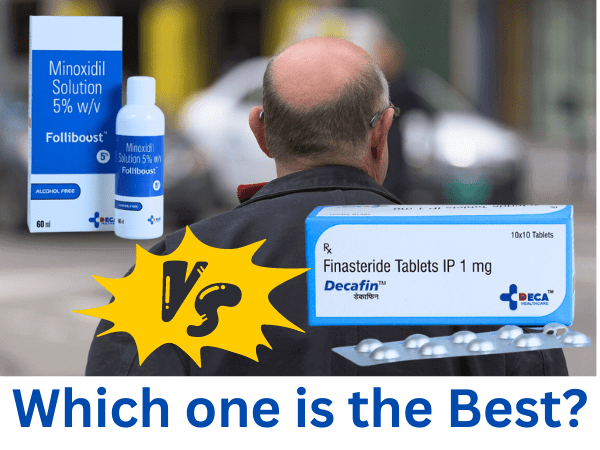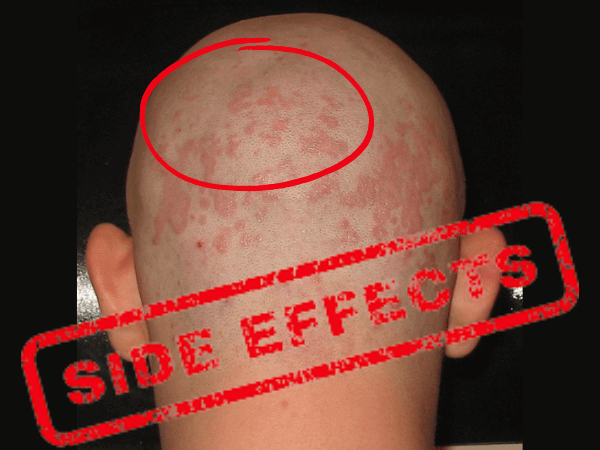Discover the ultimate showdown: Finasteride vs Minoxidil. Unravel the best hair loss treatment for you—expert insights & comparisons. Read more!

Minoxidil Review
Midlife hair loss can be upsetting and hurt confidence and general well-being. An over-the-counter topical treatment called minoxidil gives hope for hair growth. It is a convenient and promising choice for those in their mid-life looking for a cure for hair loss because increasing blood supply to hair follicles stimulates development and improves hair thickness.
While generally safe, getting medical advice before using is advised, and getting the best outcomes requires persistence and consistency. Take advantage of Minoxidil’s ability to make your hair healthier and appear fuller and younger.
Finasteride Review
Losing hair can be upsetting, particularly in middle age. A viable remedy is the FDA-approved oral drug finasteride. Cutting down hair loss and promoting regrowth is possible by blocking the conversion of testosterone to DHT. It is incredibly successful for frontal and crown hair loss patterns. Although there are some adverse effects, such as diminished libido, they are uncommon and treatable. Since benefits could not show for months, a long-term commitment is necessary. Finasteride might be a good choice for people looking to fight male pattern baldness and regain confidence in their looks with the proper investigation and counseling.
Finasteride Promises
The benefits of finasteride are mostly related to its active component, “Finasteride.” Its primary goal is to treat male pattern baldness (androgenetic alopecia) in men. The following are the main advantages attributed to finasteride:
- Hair Loss Prevention: The mechanism by which finasteride works is to stop the enzyme 5-alpha-reductase from turning testosterone into the hormone DHT. DHT causes male pattern baldness in individuals genetically predisposed to hair follicle shrinkage. Finasteride aids in many men’s efforts to stop additional hair loss by lowering DHT levels.
- Hair Regrowth: Besides stopping hair loss, finasteride has shown the ability to stimulate hair regrowth in certain people. In regions where hair has been thinning, it offers a more suitable environment for hair follicles to promote new hair development.
- Improved Hair Density: Finasteride can gradually increase hair density by stimulating renewal and decreasing hair loss. As a result, the hair thickens and fills out, giving the person a more youthful appearance.
Finasteride Limitations
Finasteride may affect people differently, and each person will respond differently.
It is important to remember that Finasteride’s benefits are primarily directed toward treating male pattern baldness in men and are not intended for usage in women, particularly those who are pregnant or trying to get pregnant due to possible hazards to the fetus.
Minoxidil Promises
The main focus of Minoxidil’s claims is its main component, “Minoxidil.” Treatment of hair loss and encouraging hair regrowth in both men and women are the main priorities. The following are the main advantages of minoxidil:
- Hair Regrowth: As a vasodilator, minoxidil opens up blood vessels to increase the flow of blood to the hair follicles. In regions where hair loss occurs, this stimulation of blood circulation in the scalp might encourage the creation of new hair by reawakening dormant hair follicles.
- Slowing Hair Loss: Minoxidil might lessen the hair loss rate and promote hair regrowth. It might lengthen the hair cycle’s anagen (growth) phase, slowing the rate at which hairs transition into the telogen (resting) phase and eventually fall out.
- Suitable for Both Genders: Minoxidil is a versatile therapy choice for people suffering from hair loss regardless of gender because it is approved for usage in both men and women, in contrast to several other hair loss therapies that are gender-specific.
- Ease of Application: The topical solution or foam form of minoxidil makes it simple to apply directly to the scalp. It is easy to incorporate into regular activities because of its simple application method.
Minoxidil Limitations
While Minoxidil has proven beneficial in encouraging hair regrowth and decreasing hair loss, it’s crucial to recognize that individual reactions may differ. Results are usually slow, so it can take a few months to see any real progress.
However, androgenetic alopecia (male or female pattern baldness) sufferers benefit most from minoxidil. It might be less helpful for other types of hair loss brought on by various underlying reasons.
Note: Before using Minoxidil or finasteride, you must speak with a medical practitioner to review the potential advantages, risks, and suitability for your hair loss issue. Regular checkups with a healthcare professional are also crucial to track development and manage any problems that could arise during therapy
Finasteride vs minoxidil Results
The effectiveness of finasteride and minoxidil, two different hair loss treatments, will depend on the patient’s unique circumstances and the type of hair loss being treated. The typical outcomes for each are summarized below:
To begin with, finasteride results are typically gradual and appear after many months to a year of constant treatment. A slowing in hair loss is expected in men, and some may even see hair growth, especially in the crown and frontal regions of the scalp.
However, the results of More or Less Minoxidil are gradual and can take a while to show. In the case of minoxidil, the same experiences apply, including enhanced hair density and regrowth in balding areas.
Individual reactions to minoxidil can vary, just like those to finasteride. While some individuals might see a significant improvement, others might benefit less dramatically. Furthermore, the hair growth brought on by minoxidil may only be short-lived, and stopping the medication may bring on a relapse of hair loss.
Is Finasteride or Minoxidil a Scam

No, minoxidil or finasteride are not a fraud. Finasteride and minoxidil are both practical and FDA-approved treatments for hair loss. They have undergone thorough research and have successfully treated hair loss in numerous people.
- Finasteride:
An oral medication called finasteride blocks the 5-alpha-reductase enzyme, which turns testosterone into dihydrotestosterone (DHT). Androgenetic alopecia, or male pattern baldness, is associated with DHT. The mechanism of action of finasteride has been thoroughly studied, and it has demonstrated promising outcomes in many men with androgenetic alopecia by decreasing hair loss and encouraging hair regeneration.
- Minoxidil:
A topical solution or foam called minoxidil is administered directly on the scalp. Although the precise mechanism of action is still unknown, it is thought to enhance blood flow to hair follicles, encouraging hair regeneration. The effectiveness of minoxidil in promoting hair growth in both men and women experiencing various types of hair loss has also been thoroughly examined.
Remember that these treatments’ efficacy is not a “quick fix,” and outcomes can require patience and consistency. Any items or treatments promising unrealistically quick results should be avoided since they could be deceptive or dangerous. Stick with trusted brands and FDA-approved drugs like finasteride and minoxidil for safe and efficient hair loss control.
Finasteride and Minoxidil side effects

Although most users tolerate these adverse effects well, finasteride and minoxidil have some. Before starting either medicine, it’s crucial to be informed of possible adverse effects and speak with a doctor. The following are typical adverse reactions to minoxidil and finasteride:
Finasteride Side Effects:
- Sexual adverse Effects: Men who use finasteride occasionally report having sexual adverse effects, including decreased libido, erectile dysfunction, or changes in ejaculation. However, these adverse effects are rare, and most men tolerate finasteride without any sex problems. If present, these adverse effects may go away if the medicine is stopped.
- Breast Tenderness or Enlargement: Finasteride use is rarely associated with breast tenderness or enlargement (gynecomastia). Usually, this side effect goes away after the medicine is stopped.
- Allergic reactions: Finasteride can cause allergic reactions in a small percentage of people, which might manifest as skin rash, itching, or swelling. If any indications of an allergic reaction appear, get medical help immediately.
Minoxidil Side Effects:
- Scalp Irritation: Some users may notice minor itching, redness, or irritation of the scalp where the application was made. This irritation, typically transient, can be reduced by adhering to the recommended application instructions.
- Unwanted Hair Growth: If minoxidil is not used correctly, it can occasionally lead to hair growth in places it is not intended, such as the hands or face.
- Systemic Side Effects: Although rare, systemic side effects from minoxidil might occasionally include light-headedness, a rapid heartbeat, chest pain, or trouble breathing. Any of these symptoms must be treated medically right once.
Despite the possibility of side effects, most users tolerated both drugs well. Always take these drugs as prescribed, and notify your doctor immediately if any side effects are worrisome. They may advise on the correct use and required modifications to guarantee the most significant outcomes with the slightest chance of negative responses.
Final Takeaway
Finasteride and minoxidil are potent solutions that stand out in the fight against hair loss. Finasteride is, so far, an effective treatment for male pattern baldness because it targets the underlying cause of hair loss by blocking DHT, decreasing hair loss, and encouraging regrowth.
While minoxidil, a versatile option for both sexes, promotes blood flow to encourage regrowth.
Rest assured that the choice is yours to make, supported by healthcare professionals and with persistence and patience as your allies. Accept your path to regaining your self-confidence and having healthy hair.
FAQ
How dangerous is finasteride?
Finasteride may cause adverse effects; see a physician. Although generally safe, some people may have breast discomfort or experience sexual side effects.
What are minoxidil 5% topical side effects on men?
Men who use minoxidil 5% topical side effects may experience scalp itchiness, facial hair growth, and discomfort. Rarely, it could result in chest discomfort or dizziness.
Finasteride vs minoxidil which one is the best?
The “best” choice changes depending on the circumstances. Male pattern baldness is targeted with finasteride, which inhibits DHT, whereas minoxidil encourages hair growth in both sexes. But finasteride is usually thought to work better for male pattern baldness than minoxidil.

